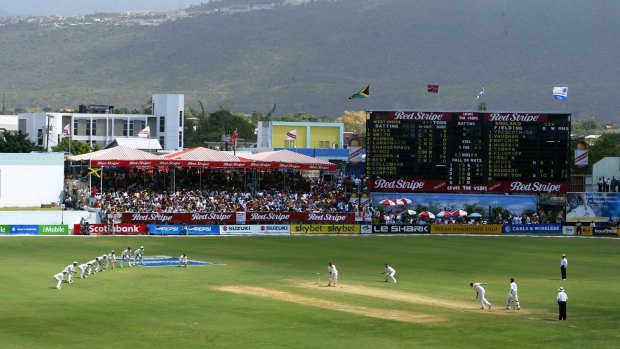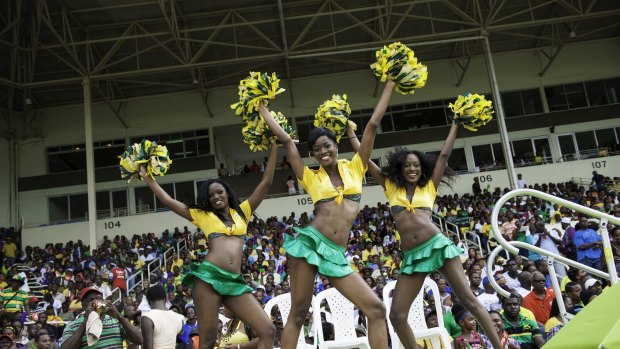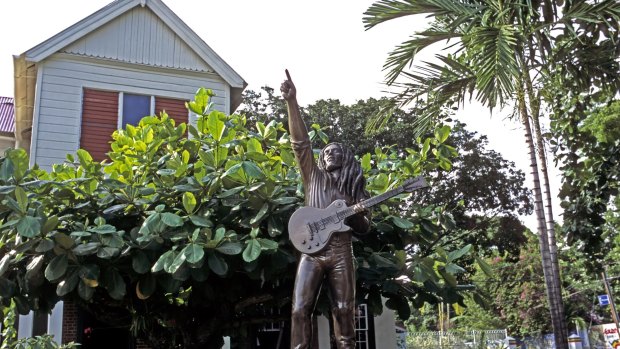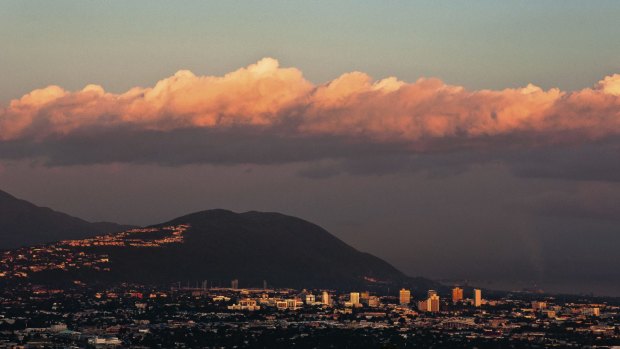This was published 9 years ago
Why Australians should visit Kingston, Jamaica: More than just a cricket capital
By John Huxley

A Test match at Sabina ParkCredit: Getty Images
We've visited the surprisingly stately home of Bob Marley and seen the hammock in which the late, dearly loved reggae singer would gently swing, smoking a spliff, gazing out towards the Blue Mountains, seeking inspiration for his next song.
And someone has shown us the bullet holes left in his wooden, bedroom wall by would-be assassins.
We've driven some 20 kilometres up a narrow, crumbling road, through a Jamaican army camp, to meet Jason Sharpe, who claims, with much justification, to grow the best Blue Mountains coffee, on his spectacular Clifton Mount Estate, a property dating back to 1732.

Cheerleaders cheer their team during the Twenty first Match of the Cricket Caribbean Premier League.Credit: Getty Images
And he has shown us one of his favourite ways to make coffee: dribbling, not-quite-boiling water from a long, goosenecked, silver kettle, over coffee gently nestling in a filter. It works!
We've dropped in to the Jamnesia Surf Camp at Bull Bay where Billy Mystic, a bearded, dreadlocked Rastafarian, his wife, five children, multi-national helpers and dogs teach visitors from all over the world to catch a local wave.
And Billy, who is also a musician and popular TV soapy star, has sketched out energetically how he could secure boards for the poor local kids if only more tourism spending could be directed his way.

Bob Marley Museum, Kingston Credit: Getty Images
There's more; so much more to see and do and eat and drink and share and learn and text home about in the Jamaican capital of Kingston, which may be reached via Los Angeles and Miami in less time that it takes to make the long haul to London.
And for Australians, especially, there is another good reason to visit a city that is surprisingly rich in history and, apart from a few clearly defined areas, as reassuringly safe as any other world capital.
The next time those well-travelled tourists, the Australian cricket team and their green-and-gold army of supporters go overseas it will be to that most exotic, exciting and colourful of destinations, the West Indies.

Kingston, Jamaica at sunset. Credit: iStock
From the end of May, the Aussies are scheduled to play three first-class matches in the Caribbean: a friendly and two Tests, at Windsor Park, Roseau, in Antigua, and, more significantly, at Sabina Park in Kingston, Jamaica.
Not only will the Sabina Park match offer a red-hot, "goat-curry", warm-up for the Ashes tour of England, starting a few weeks later, but it is the West Indian venue that most easily evokes vivid memories of earlier clashes with Australia.
So many other attractions does Jamaica offer that travellers don't have to be cricket fans to enjoy the island, which boasts stunning scenery, friendly people and a list of celebrity visitors including Australian-born movie star Errol Flynn, novelist Ian Fleming, the creator of James Bond, and British war leader Winston Churchill.
But like a speaking a bit of a foreign language, a "smattering of cricket" certainly enriches the overall holiday experience.
As Hilary Beckles and Brian Stoddart explain in Liberation Cricket, a study of the game in the Caribbean, "In the West Indies the Test match is not so much a game as a collective ritual ... a social drama in which almost all of the basic tensions and conflicts within the society are played out symbolically."
So what should the Australian visitor know?
First, in recent years, internal wrangling has sometimes made Windies cricket look more "collapso" than "calypso". New local heroes, such as Usain Bolt, the "fastest man on earth", now jostle cricket giants such as Chris Gayle for a nation's attention.
And, second, the old, concrete-hard wickets, on which a string of fast-bowlers such as Michael Holding, Wayne Daniel, Vanburn Holder, and more recently Curtly Ambrose and Courtney Walsh, terrorised visiting batsmen, are no more.
As the Sabina Park's 70-year-old groundsman Charlie Joseph, tells me, "Not making them wickets no more." Why not? "You better ask boss men," suggests Charlie, who says he was given a tractor and told to get on with the job when he was 16. "Only thing they say is don't take the tractor on the road."
So, no killer speedsters and no concrete tracks. But as Australian tourists (be they players or supporters) will soon discover, the ritual, the social drama, the heroes and villains, emblems and remembrances, of Jamaican cricket remain strong.
Nowhere will they be stronger than at "the park", which opened for business in 1895, hosted its first Test match in 1930 and has been a place of pilgrimage for cricket players and fans from all over the world ever since. During that time, Sabina has seen it all.
It was here in 1958 that Garry Sobers scored a record 365 not out. Ten years later it was the scene of a riot by local fans objecting to the dismissal of another local hero, Basil Butcher. Ill-advisedly, the police used tear gas to disperse the crowd.
"Not much to say about it really," says Charlie. " Butcher, him given out, crowd gets angry and then this policeman, one policeman, threws a gas can. Soon huge clouds of smoke come across."
In 1976 Indian captain Bishen Bedi called off his second innings, declaring five batsmen "retired hurt", to protect them from bodily harm being inflicted by the West Indian fast bowlers.
And in 1998 there was further controversy when a Test match against England being played on a pitch described as a "corrugated minefield" was abandoned after just 10.1 overs to prevent the visiting batsmen being "maimed or killed".
Few people know the ground better than the man who happened to be bowling at the time the controversial decision was taken, legendary fast bowler Courtney "Cuddy" Walsh, who will be guest co-hosting one of at least three Australian tour parties heading to Kingston.
Today, a frighteningly fit 52-year-old, Walsh grew up close to Sabina Park, playing for his local Excelsior High School, where he once famously took 10 wickets in an innings, and the Melbourne Cricket Club.
A specialist spinner at school who was persuaded to switch to fast-bowling as his strength and height rapidly increased, 1.97cm-tall Walsh took 519 wickets in a Test career stretching from 1984 to 2001.
He also managed, with what once commentator called "comic incompetence", to secure 43 Test ducks, a record to this day. When I jovially remind him of this record, he is unamused. "It's an important part of the game. I should have done better."
Today, he remembers the old Sabina Park with affection. "It was smaller, didn't have so many stands." Not that he is knocking the "new Sabina Park", which is, if anything, noisier, bigger and, no doubt, better informed.
So what can Aussies expect ( apart from a victory?)
Beverley McBean, park supervisor, points out to visitors the newish five-storey North Stand, full of boxes, and rooms for VIPs, officials and players, and the very new light towers.
The local Kingston Club Stand and the bare "car park" end remain unchanged, but the old "Mound" stand has been replaced, in theory, by a new "Party Stand".
Little more than a month away from the Sabina Test its site is covered in rubble. But McBean says that during the match the area should be back in "party mode", including a resident DJ, bikini-clad dancers, copious supplies of cold beer and, possibly, a plastic pool.
So, can visitors from Down Under expect a warm welcome in the Party Stand? "Of course, it'll be great fun," says McBean, who is herself a bundle of fun. "Everybody one big happy family." With 20,000 crowds, she hopes.
So what will the Australian fans, most of whom will be travelling in one of three organised groups, including a new Sydney/Kingston venture devised and organised by Australian Thea Pillay of Soon Come Jamaica Tours, make of it all?
They'll love the setting. It's stunning: Kingston's huge harbour at one end, and the Blue Mountains, source of the famous coffee, at the other. But the stadium, which does not offer tours, but can be seen in most respects from the road, can not be compared in size or design or capacity to any of Australia's Test grounds.
Moreover, the city location is not especially interesting. Significantly, visiting Australian supporters will travel to and from the park in shuttle-buses, just like their team, which will be staying at the nearby Spanish Court Hotel.
For "interesting" go instead to Hellshire Beach, to Devon House and its grounds, and one of several newish sports bars, such as Cuddy'z and Usain Bolt's Tracks and Records, to catch up on world sport elsewhere.
Or take a trip up the mountains, for high "wow factor" experiences. Amazing Views. Demanding hikes. Odd villages such as Redlight, which we are told was named for the services it advertised for frustrates soldiers. And dream resorts such as Strawberry Hill.
Courtney Walsh is looking forward to co-hosting his Australian guests. As a West Indies selector, he cannot comment on players, teams, tactics or prospects for the upcoming Tests. But he says, "I'm sure the Australian players and their many supporters will receive a warm welcome at Sabina Park."
If past history is any guide the forthcoming tests will be fiercely contested. They bring together a home side going through a poor patch, especially in Test matches, and visitors who have rarely, if ever, taken a backward step.
In his memoir, The Golden Age, former captain Ian Chappell captured the often intimidating atmosphere at Sabina Park. "The first look at the Sabina Park track is off-putting. It's a light-coloured shiny surface, which looks a lot like glass…
"There are two huge concrete walls at each end of the ground which double as sightboards and extra accommodation for the fans.
"In his heyday, [Windies fast bowler] Wes Hall used to intimidate batsmen by occasionally off the wall to begin his run-up. Not to be outdone, [his Australian counterpart] Dennis 'the menace' Lillee then did likewise."
This was not considered unusual behaviour at Sabina Park, Chappell explained, adding that the enthusiastic local crowd loved the colourful, the conflict, the "cussing" and, most of all the unexpected.
"In 1973, an announcement was made over the PA system. 'Would Mr Weekes please return home immediately as his house has burned down.' Everyone in the ground burst out laughing, but no one left.
"I guess Mr Weekes could not do much to save his house, and anyway there was a cricket match in progress."
The writer travelled as a guest of the Jamaica Tourist Board, on an itinerary devised by Soon Come Jamaica Tours.
TRIP NOTES
MORE INFORMATION
GETTING THERE
American Airlines, with code-share partner Qantas, fly to Kingston via Los Angeles and Miami.
TOURING THERE
Soon Come Jamaica Tours is running an 11-night "Taste of Jamaica Tour" including the cricket. Prices start from $1980 twin-share, not including airfares.
STAYING THERE
Kingston offers a wide range of accommodation, ranging in price from the Reggae Hostel, which has shared rooms from $20 a night, to the Jamaica Pegasus, at up to $650 a night. The author stayed in The Courtleigh Hotel & Suites in New Kingston.
TEN TIPS ON HOW TO SPEAK REGGAE CRICKET
1. "Every'ting irie" - No problem. No worries. All alright. OK. (rarely heard at West Indian cricket grounds since long-term slump in form)
2. "All fruits ripe" - Everything is all right. (rarely heard etc)
3. "Mash it up" - Good luck. (much needed by recent West Indian teams)
4. "Eedyet ting dat" - That was a stupid, idiotic thing to do. (applied to players getting out in silly ways, dropping catches etc)
5. "Upful" - Positive, cheerful. (like Australian supporters in Sabina Park. We hope)
6. "Waa'ppun? - A popular greeting (or inquiry into state of the game, from latecomer)
7. "Darkers" - Sunnies (like helmet and sun cream, essential equipment at red-hot Sabina Park"
8. "Drop legs" - To dance (as the Australians hope to do after winning the two-match series)
9. "Whole heaps" - Large quantities (what Australian opener David Warner will be looking for in runs. Also applied to Red Stripe beer consumption
10. "Kill mi dead" - Expression of certainty (once used by umpires, now obtained only after re-play"
* All phrases must be finished with the word "man" or, more cryptically, "mon".
Sign up for the Traveller Deals newsletter
Get exclusive travel deals delivered straight to your inbox. Sign up now.